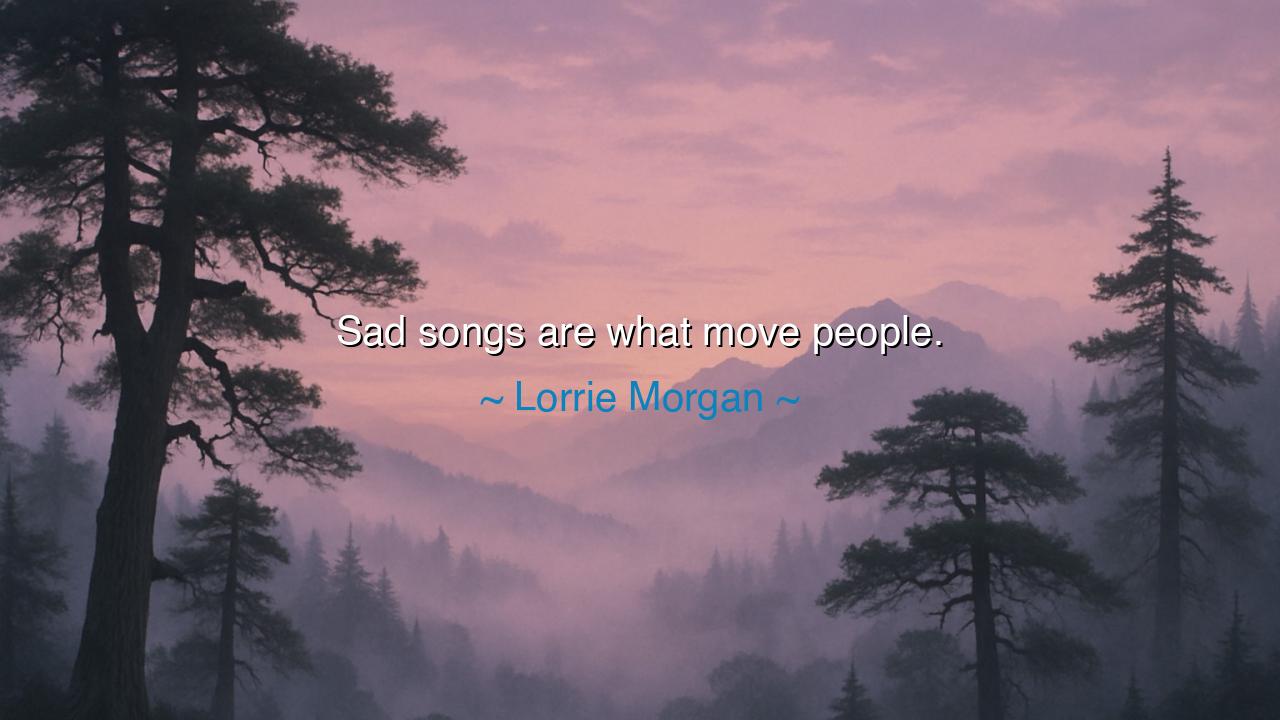
Sad songs are what move people.






Lorrie Morgan, with the voice of experience and the heart of a singer, once declared: “Sad songs are what move people.” In this brief but powerful truth, she unveiled the ancient mystery of music—that sorrow, when carried on melody, pierces deeper than joy. For laughter may charm the ear, but it is grief set to song that engraves itself upon the soul. Humanity, across centuries and civilizations, has always been most stirred not by triumphal fanfare but by the laments that echo the cries of the heart.
The power of the sad song lies in its honesty. To weep in silence is to suffer alone, but when sorrow is sung, it transforms into something shared. The listener hears their own pain reflected back to them, and in that reflection, finds solace. From the Psalms of David, which cry out from the depths of anguish, to the mournful ballads sung in every corner of the earth, the tradition is the same: sad songs move people because they speak the language of suffering, a language we all understand.
History gives us many examples. Think of the spirituals sung by enslaved Africans in the fields of America—songs born of suffering, yet filled with both pain and hope. They were sad songs, yet they carried an entire people through darkness, binding hearts together with the strength of shared sorrow. Or recall the Irish laments, keened by women over the graves of warriors and loved ones, haunting songs that did not hide grief but gave it form and dignity. These songs did not merely entertain; they moved whole nations, shaping memory and identity.
Lorrie Morgan, as a country singer, understood this deeply. Country music has always been steeped in tales of heartbreak, loss, and longing. Its greatest treasures are not the cheerful tunes but the ballads of broken love, empty homes, and roads walked alone. Why? Because, as she said, it is the sad songs that move us. They remind us we are human, that our tears connect us as much as our laughter, and that there is beauty even in sorrow.
Yet there is more to this truth. Sad songs move people not only because they mirror grief, but because they reveal resilience. To sing of pain is to rise above it, to turn wound into wisdom, anguish into art. When a listener hears such a song, they are not only moved to tears; they are moved to endure, to keep walking, to remember that their suffering, too, may one day become part of a greater story. Thus, sadness does not paralyze—it propels.
The lesson for us is profound: do not shy away from sorrow, and do not silence it. When grief comes, give it form—whether in words, in music, or in honest expression. By doing so, you not only free yourself but give others the gift of recognition. Remember that sadness shared becomes lighter, and when it is shaped into song, it becomes eternal. The world needs not only the songs of triumph but the ballads of brokenness, for it is in these that we see the depth of our humanity.
Practically, this means we must learn to listen deeply. Do not only seek music or stories that make you laugh—embrace those that make you cry. Let them remind you of your own trials, and let them awaken compassion for the suffering of others. And if you are a creator, do not be afraid to pour your sorrow into your art, for it may be the very thing that moves another soul to healing.
Thus, the words of Lorrie Morgan stand as both a revelation and a challenge: “Sad songs are what move people.” They are the heartbeat of humanity, the bridge between isolated souls, the balm for wounds unseen. May we not flee from their power, but honor it, and in honoring it, find the courage to transform our own sadness into something that moves the world.






AAdministratorAdministrator
Welcome, honored guests. Please leave a comment, we will respond soon